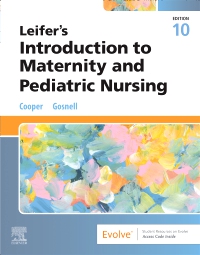Leifer’s Introduction to Maternity and Pediatric Nursing, 10th Edition
by Kim Cooper, MSN, RN and Kelly Gosnell, MSN, RN
Paperback
ISBN:
9780443127571
Copyright:
2026
Publication Date:
04-08-2025
Page Count:
912
Imprint:
Elsevier
List Price:
$107.99
Build the clinical judgment skills you need to provide quality care for maternity and pediatric patients! Clear and easy to read, Leifer’s Introduction to Maternity and Pediatric Nursing, Tenth Edition describes how you can provide effective, evidence-based care for women during pregnancy, labor, and delivery, and for newborns and growing children. The text spans the continuum of child development, making it easy to locate information by organizing topics from simple to complex and from health to illness. Another hallmark of the book is its strong focus on family-centered care, health promotion, and illness prevention. From nursing educators Kim Cooper and Kelly Gosnell, this bestselling text helps you prepare for the Next Generation NCLEX-PN® Exam and for the expanding role of the nurse in today’s healthcare practice.
-
-
- NEW! Updated medication tables provide quick access to information about commonly used drugs
- NEW! Updated content reflects the latest research and technology, the latest standardized guidelines, and best practices in LPN/LVN care
- NEW and updated photos and illustrations reinforce the book’s concepts, with more representation of diversity
- Unfolding case studies follow one family through the conception and birth process, and include open-ended critical thinking questions applying the content to practice
- Case studies and questions for the Next Generation NCLEX Exam® (NGN) help you apply theory to practice and prepare for the NCLEX-PN examination
- Get Ready for the NCLEX® Examination! at the end of each chapter includes a summary of key points, online resources, review questions, and critical thinking questions
- More than 25 nursing care plans include nursing diagnoses and goals, nursing interventions, and rationales, along with clinical judgment questions to promote critical thinking skills
- Nursing guidelines reflect the World Health Organization’s Baby-Friendly Hospital Initiative, alternative therapies, immunization mandates, emergency preparedness, preventing medication errors, and more
- Detailed nursing skills cover a wide range of maternal and pediatric nursing interventions
- Patient Teaching boxes help you communicate instructions for self-care with patients and families
- Nursing tips include practical, evidence-based information applicable in the clinical setting
- Cultural Considerations boxes help you address the needs of culturally diverse patients and families
- Safety alerts highlight medication errors, the importance of protecting patients and others from accidents, and the spread of disease
-
UNIT I: AN OVERVIEW OF MATERNITY AND PEDIATRIC NURSING
1. The Past, Present, and Future
2. The Nurse’s Role in Women’s Health Care
UNIT II: MATERNAL-NEWBORN NURSING AND WOMEN’S HEALTH
3. Human Reproductive Anatomy and Physiology
4. Fetal Development
5. Prenatal Care and Adaptations to Pregnancy
6. Nursing Care of Women With Complications During Pregnancy
7. Nursing Care of Mother and Infant During Labor and Birth
8. Nursing Management of Pain During Labor and Birth
9. Nursing Care of Women With Complications During Labor and Birth
10. The Family After Birth
11. Nursing Care of Women With Complications After Birth
12. The Term Newborn
13. Preterm and Postterm Newborns
14. The Newborn With a Perinatal Injury or Congenital Malformation
UNIT III: THE GROWING CHILD AND FAMILY
15. An Overview of Growth, Development, and Nutrition
16. The Infant
17. The Toddler
18. The Preschool Child
19. The School-Age Child
20. The Adolescent
UNIT IV: ADAPTING CARE TO THE PEDIATRIC PATIENT
21. The Child’s Experience of Hospitalization
22. Health Care Adaptations for the Child and Family
23. Complementary and Alternative Therapies in Maternity and Pediatric Nursing
24. The Child With a Sensory or Neurological Condition
25. The Child With a Musculoskeletal Condition
26. The Child With a Respiratory Disorder
27. The Child With a Cardiovascular Disorder
28. The Child With a Condition of the Blood, Blood-Forming Organs, or Lymphatic System
29. The Child With a Gastrointestinal Condition
30. The Child With a Genitourinary Condition
31. The Child With a Skin Condition
32. The Child With a Metabolic Condition
33. The Child With a Communicable Disease and Immune Response
34. The Child With an Emotional or Behavioral Condition
APPENDIXES
A. Use of Personal Protective Equipment When Caring for Patients With Confirmed or Suspected COVID-19
B. The Joint Commission’s List of Dangerous Abbreviations, Acronyms, and Symbols
C. Commonly Used Abbreviations in Maternity and Pediatric Nursing
D. Common Spanish Phrases Used in Maternity and Pediatric Nursing
E. Conversion of Pounds and Ounces to Grams for Newborn Weights
F. Normal Vital Signs and Temperature Equivalents for Infants and Children
G. Pediatric Laboratory Values Reference
References
Glossary
Index
-
Kim Cooper, MSN, RN, Dean and Associate Professor, School of Nursing, Ivy Tech Community College, Terre Haute, Indiana, USA and Kelly Gosnell, MSN, RN, Department Chair and Associate Professor, School of Nursing, Ivy Tech Community College, Terre Haute, Indiana, USA







 as described in our
as described in our 